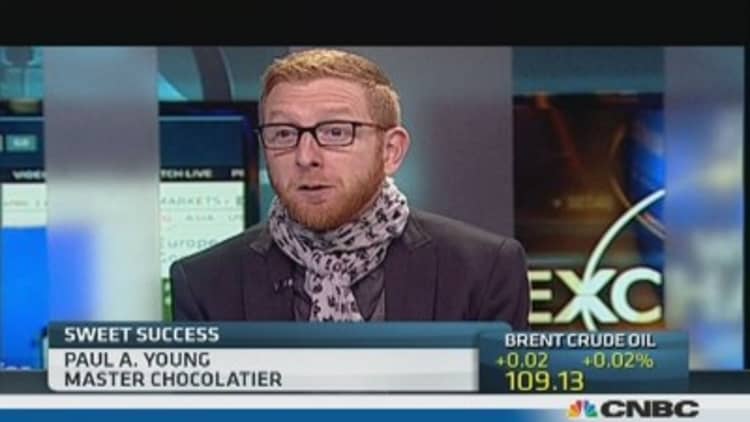The humble bar of chocolate could soon change beyond recognition as palm oil, chemical flavorings and fillers replace increasingly scarce cocoa beans and expensive ingredients. A high-cocoa content chocolate bar is in danger of becoming a luxury product.
According to research by Mintec, the raw material costs involved in producing a generic milk chocolate bar weighing 100 grams have increased 28 percent in the year through to October.
Cocoa butter, the vegetable fat extracted from cocoa beans which makes up about a quarter of every chocolate bar, rose 63 percent in the past 20 months, reaching a four-year high. Whole milk powder, another major component, rose over 20 percent. These hikes more than offset the prices for cocoa powder and white sugar dropping over 50 percent and 15 percent respectively since January 2012.
As Simona Gambarini, research analyst at ETF Securities tells CNBC the price of the cocoa bean – from which the powder and butter are made – is up 22 percent in the year to date, hitting a two-year high in early October due in part to dry weather in West Africa "coupled with Ghana's decision to gradually reduce fertiliser subsidies and phase out pest and disease control".
(Read more: Crumbs! Starbucks in a jam over the duffin)
The West African region, with Cote d'Ivoire and Ghana in the lead, is a major global producer of cocoa beans so as Gambarini explains, weather dynamics and social tensions there "are likely to have a strong impact on cocoa prices".
Worse, for Angus Kennedy, former chocolate taster for some of the world's biggest chocolate manufacturers, if chocolatiers continue with "business as usual", the world could find itself with a shortage of cocoa beans within seven years.
"The industry is keeping it fairly quiet at the moment, but they're all looking very carefully at the situation over the next few years," he says.
One factor that could have an important influence on the supply and demand of cocoa is the emerging markets' increasing appetite for sweet treats.
Currently, the world's biggest eaters of chocolate are in Europe. On average, each European will eat 8 kilograms (17 pounds) of chocolate a year, whereas in China and India the yearly consumption per capita is 100g and 700g respectively, according to Euromonitor International.
For the global market research and consulting company TechSci, the Indian chocolate market's compounded annual growth rate should be around 21 percent from 2013-2018 to reach $3.2 billion in 2018.
Other markets with huge expected increases include Russia and China. In its "The Chocolate of Tomorrow" report released in June 2012, consultancy KPMG forecast that the Russian market should grow 45 percent by 2016 to reach $8 billion, and that Chinese sales had grown by a yearly average of 40 percent since 2009.
Angus Kennedy warns that world production is not equipped for the emerging markets' growing appetite in the delicacy.
"If the industry doesn't do anything, with the increased appetite in Asia, then we'd see a shortage of cocoa butter," he says.
Farmers need a lot more money to invest in pesticides and new trees, he adds.

"They don't have a lot of money, so there are lots of diseased trees or the trees are very old. Each newly planted tree needs four to five years to produce beans".
(Read more: Sugar: The food industry's tobacco moment?)
An increase in the cost of the chocolate bar's raw materials either means the manufacturers will have to absorb the price rises or the final product would have to become more expensive. The bulk of chocolate products' sales takes place in supermarket (42 percent according to KPMG), so analysts forecast mass market manufacturers will introduce other ingredients to keep their products within reach of low-income earners.
Therefore, there will be more imitation flavorings, argues Kennedy, and cocoa butter will be used less in favour of other sources of vegetable fat such as palm oil. Confectionary products will increasingly be filled with nuts, almonds and raisins. And the 100g chocolate bar will have "loads of inclusions and less cocoa content".
Paul Young, founder and master chocolatier at Paul A. Young Fine Chocolates told CNBC that "the key is sustainability". Chocolatiers need to buy their cocoa straight from the grower as the grower is more likely to invest back into his plantation. He also points that that the average Ecuadorian grower is 62 year-old and by buying straight from the grower would attract younger people.
But while mid-range chocolate bars will be hit the hardest, the high-end segment with 70% cocoa content and over however, will continue to flourish.
"People are prepared to pay £70 per kilogram for chocolate" explains Angus Kennedy.
"The growth is massive, but for really good quality and creative products," says Paul Young, "It's huge, affordable luxury, some of it is reassuringly expensive" and people love that "luxurious feeling".
(Read more: Chocolate puts market for sweets on a sugar high)
Follow us on Twitter: @CNBCWorld


